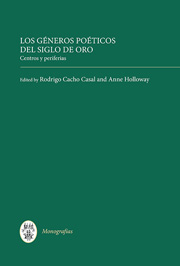Book contents
- Frontmatter
- Dedication
- Contents
- Índice de ilustrationes
- Índice de colaboradores
- Introducción: Géneros, centros, periferias
- I DEL CENTRO A LA PERIFERIA: GÉNEROS Y CONTRAGÉNEROS
- II AGUDEZA, RETÓRICA Y EMBLEMÁTICA
- 5 Invenciones cancioneriles y tradición emblemática: de la sutileza cuatrocentista a la agudeza áurea
- 6 Poesía y emblemática en el Siglo de Ora
- 7 Poesía y retórica en el Siglo de Ora: cuestiones en torno al estilo culto
- III GÓNGORA Y SU ESTELA
- IV POESÍA COLONIAL: EL NUEVO CENTRO
- V LA POESÍA Y SUS MARCOS: MANUSCRITOS, ANTOLOGÍAS, MISCELÁNEAS
- Bibliografía
- Índice onomástico
5 - Invenciones cancioneriles y tradición emblemática: de la sutileza cuatrocentista a la agudeza áurea
from II - AGUDEZA, RETÓRICA Y EMBLEMÁTICA
Published online by Cambridge University Press: 05 September 2013
- Frontmatter
- Dedication
- Contents
- Índice de ilustrationes
- Índice de colaboradores
- Introducción: Géneros, centros, periferias
- I DEL CENTRO A LA PERIFERIA: GÉNEROS Y CONTRAGÉNEROS
- II AGUDEZA, RETÓRICA Y EMBLEMÁTICA
- 5 Invenciones cancioneriles y tradición emblemática: de la sutileza cuatrocentista a la agudeza áurea
- 6 Poesía y emblemática en el Siglo de Ora
- 7 Poesía y retórica en el Siglo de Ora: cuestiones en torno al estilo culto
- III GÓNGORA Y SU ESTELA
- IV POESÍA COLONIAL: EL NUEVO CENTRO
- V LA POESÍA Y SUS MARCOS: MANUSCRITOS, ANTOLOGÍAS, MISCELÁNEAS
- Bibliografía
- Índice onomástico
Summary
Entre los antecedentes medievales de la emblemática hispana, se suele mencionar de manera incidental la modalidad cuatrocentista de las invenciones, bien representada en impresos tan célebres como el Cancionero general. Los paralelismos de invención y emblema son, en efecto, notorios: a grandes rasgos, se asocian un elemento figurativo y la palabra, que se iluminan de manera recíproca.
Ambas tradiciones tienen en la heráldica un indudable tronco común. Pero, en consonancia con la extraordinaria difusión de la colectánea de Hernando del Castillo, es seguro que los emblemistas españoles del Siglo de Oro conocían de primera mano el modelo de la invención, vivo en el ceremonial cortesano de la época de los Reyes Católicos y asimismo manifiesto en la narrativa sentimental y el libro de caballerías, géneros que no solo recogieron numerosas invenciones, sino que incluso recrearon los certámenes que las animaban.
El mismo Baltasar Gracián, en las dos redacciones de Agudeza y arte de ingenio, apunta a una protoemblemática ibérica manifiesta ya en ejemplos del siglo XV. Y el interés de la poética graciana no termina aquí, pues incorpora interesantes apuntes sobre la evolución de estos juegos sutiles desde el Cuatrocientos hasta el siglo XVII, que ahora nos proponemos examinar.
- Type
- Chapter
- Information
- Los géneros poéticos del Siglo de OroCentros y periferias, pp. 85 - 108Publisher: Boydell & BrewerPrint publication year: 2013



